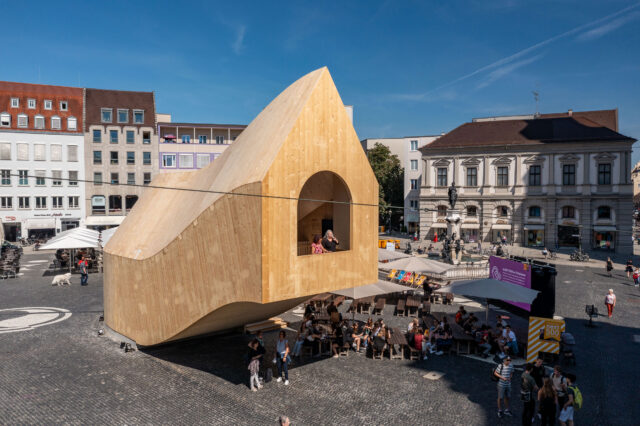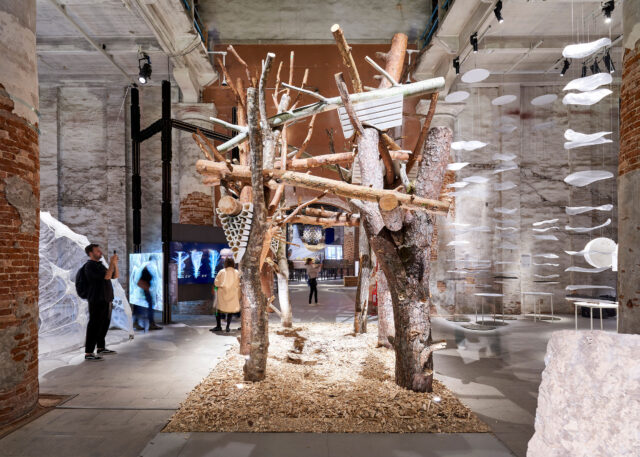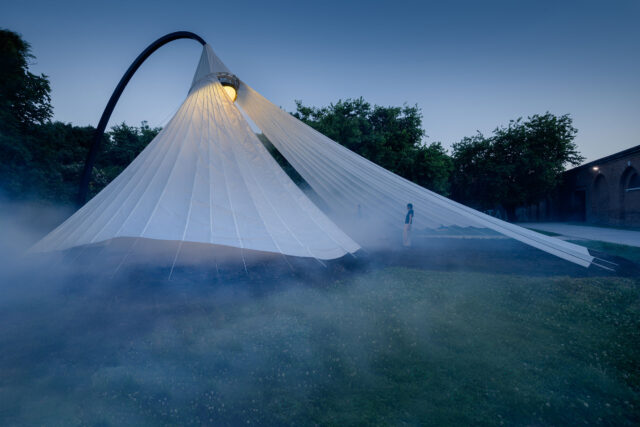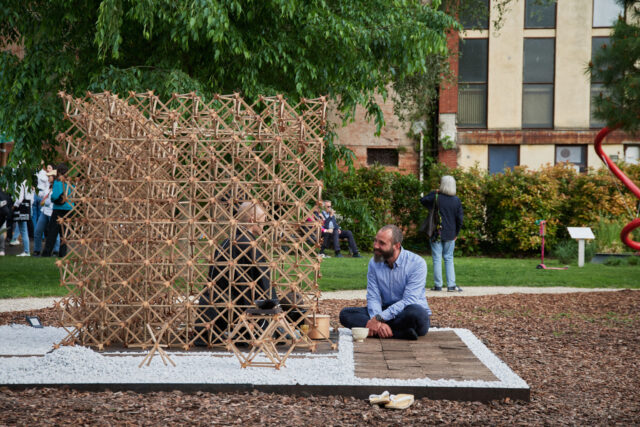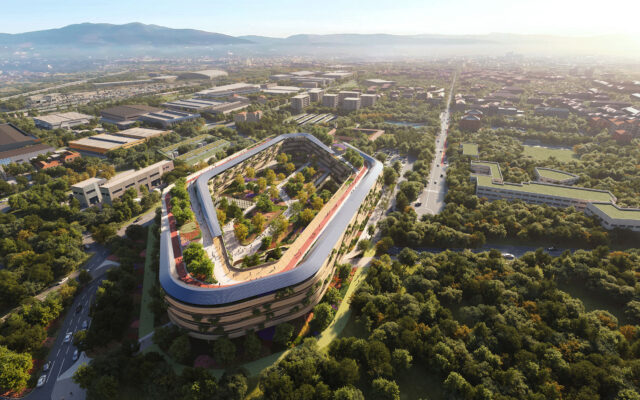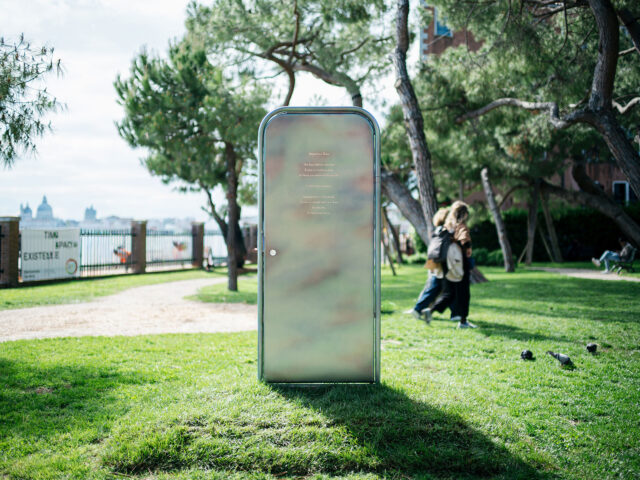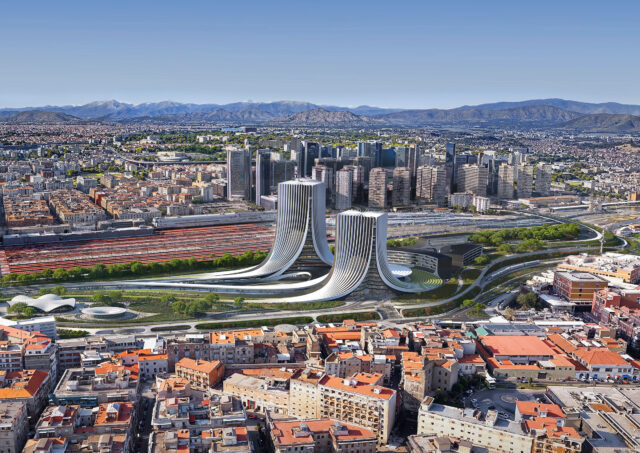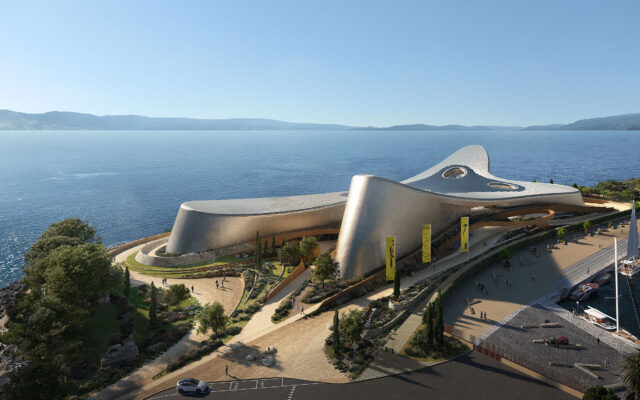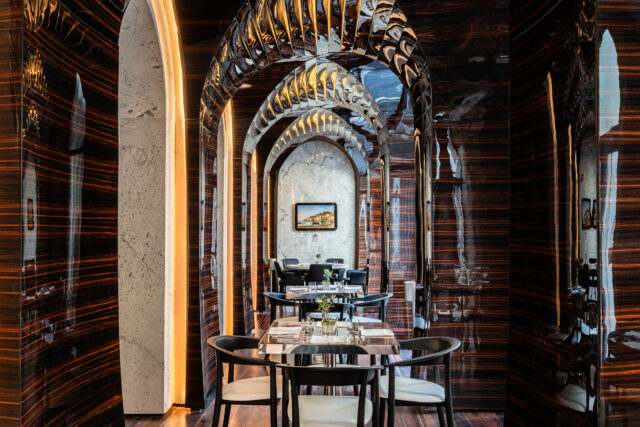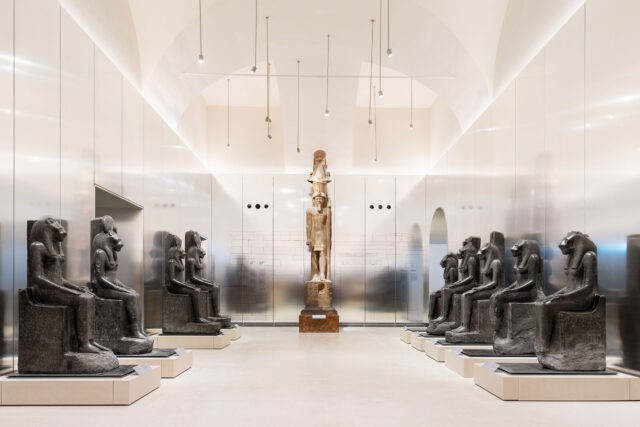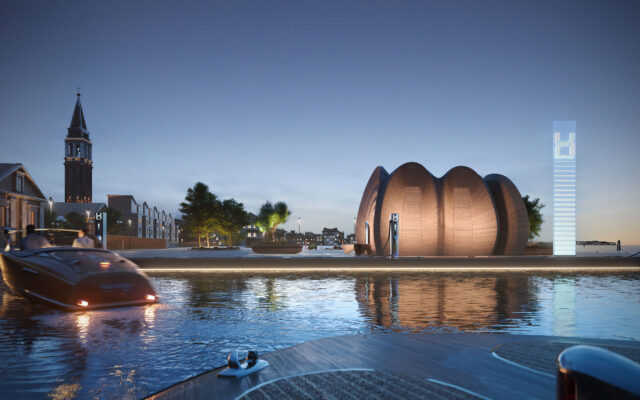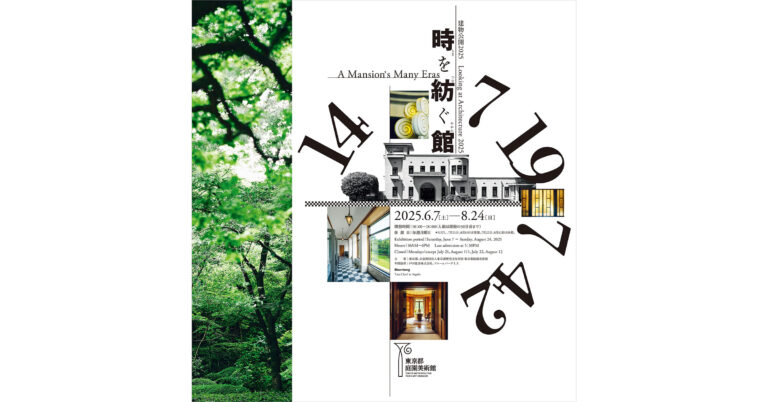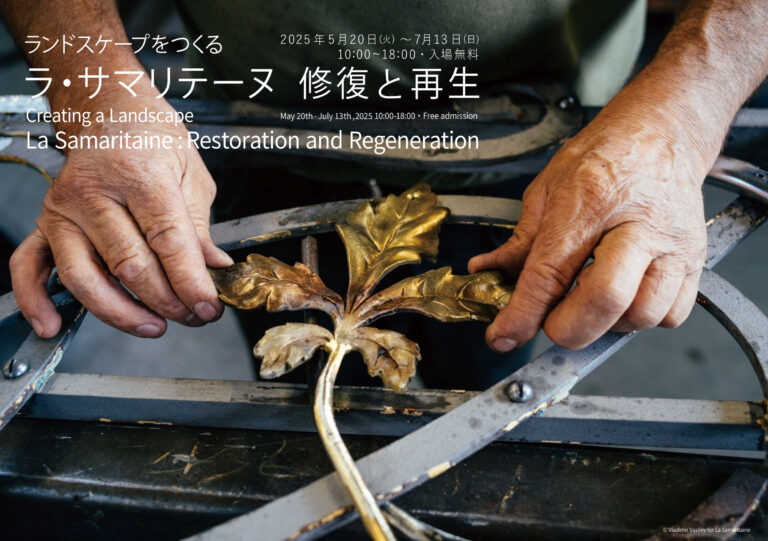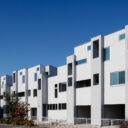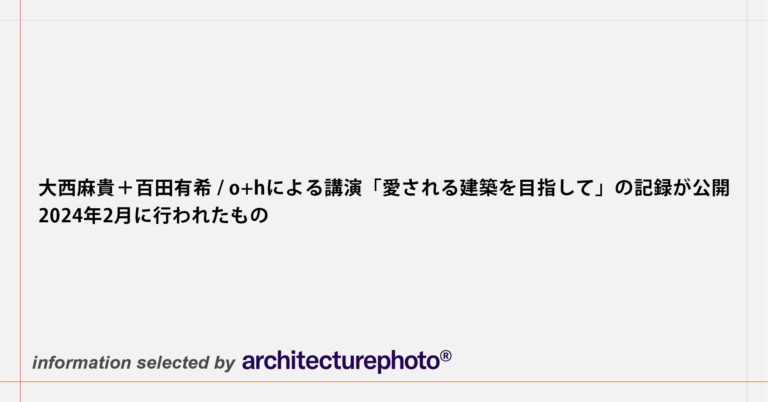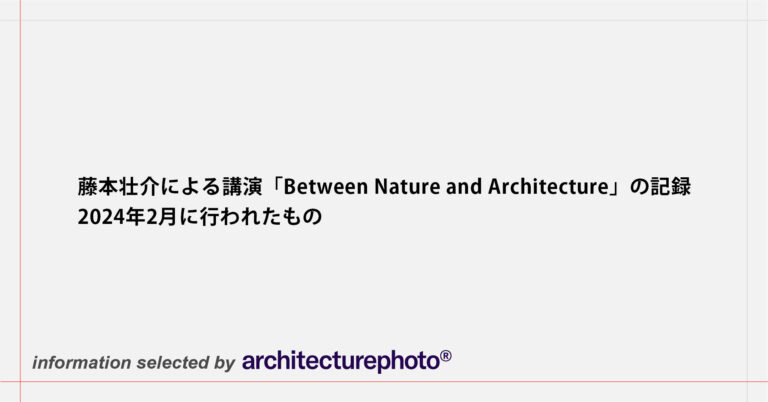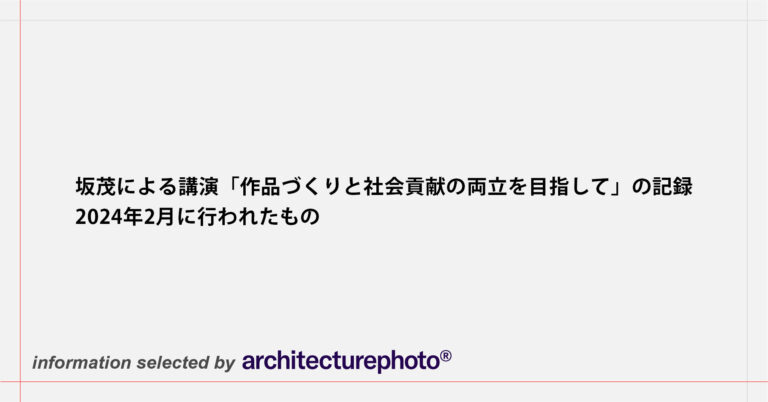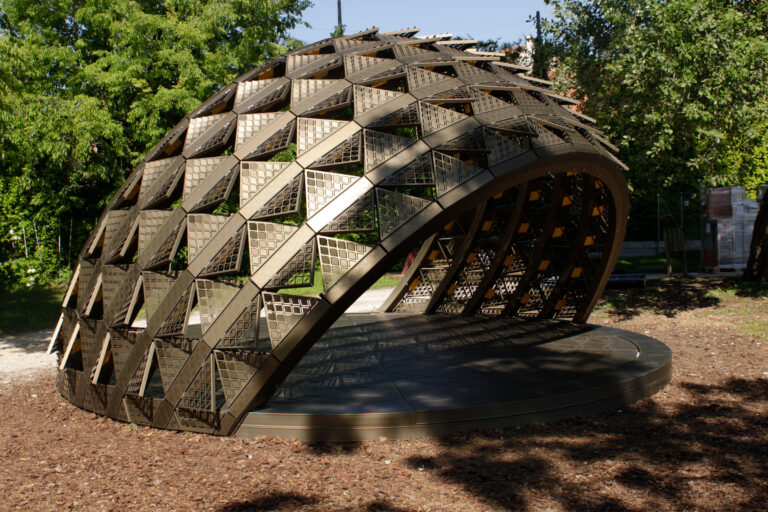
SHARE MVRDVによる「SOMBRAパヴィリオン」。ヴェネツィアでの展覧会の為の作品。環境と調和する新しい建築の実例として、モーター無しでパネルが開閉して遮光する“動的建築要素”を考案。企業とのコラボでソフトロボティクスの原理に着想を得た機構を実装




MVRDVによる「SOMBRAパヴィリオン」です。
ヴェネツィアでの展覧会“Time Space Existence”の為の作品です。建築家は、環境と調和する新しい建築の実例として、モーター無しでパネルが開閉して遮光する“動的建築要素”を考案しました。企業とのコラボでソフトロボティクスの原理に着想を得た機構を実装しています。展覧会の公式サイトはこちら。会期は、2025年の晩秋まで。
こちらはリリーステキストの翻訳です(文責:アーキテクチャーフォト)
太陽への賛歌:ヴェネツィアのSOMBRAパヴィリオンの動的遮光システムは、電子機器やモーターを必要としません。
ヴェネツィアで開催される「タイム・スペース・エグジスタンス(Time Space Existence)」展のために、MVRDVはMetadecor、Airshade、Alumetなどと協力して、SOMBRAパヴィリオンを制作しました。その形状はヘリオドン装置に着想を得ており、今後6か月間にわたり、この「太陽への賛歌」はヨーロピアン・カルチュラル・センターのジャルディーニ・マリナレッサで動的な遮光構造を提供します。SOMBRAパヴィリオンは、その名称がラテン語の「太陽(sol)」と「影(umbra)」を組み合わせた混成語であるように、革新的な技術のデモンストレーション手段として機能します。それは、電子機器やモーターを使用せず、完全に受動的な物理原理のみに基づいて動作する動的建築要素です。
このパヴィリオンの6本の金属製リブは太陽の方向に傾けられており、上部と下部のアーチはそれぞれ夏至と冬至の太陽の角度に対応しています。これらのアーチは、以前のプロジェクトから再利用された梁で作られており、三角形のパネルを支えています。そして、そのパネルは、MetadecorのMD Formaturaによる穴あきスクリーンのおかげで、斑(まだら)状の日陰を生み出します。これらのパネルには蝶番が取り付けられており、太陽の動きに応じて開閉します。静止状態では、遮光スクリーン越しの眺望を最大限に確保するために、パネルは開いた状態になっています。しかし、強い直射日光が当たると、各パネルは閉じて最大限の日陰を提供します。その印象はまるで生きている有機体のようで、太陽が空を移動するにつれて姿勢を変え、曇りの時にはため息をつくかのようです。
これらすべては、Airshadeのおかげで、自然の物理原理のみを用いて実現されています。この構造のアーチ状のリブには、一連の小型エアキャニスターが内蔵されています。構造の一部が太陽によって加熱されると、キャニスター内の圧力が上昇し、空気が構造体とパネルをつなぐ小さなエアバッグに送り込まれます。ソフトロボティクスの原理に着想を得た機構を用い、エアバッグが膨らむと筋肉のように収縮し、蝶番にあるバネの力に対抗してパネルを閉じます。したがって、このパヴィリオンは、光・熱・換気を動的に制御する建築実験であり、運用時の炭素排出量はゼロです。
「気候危機が加速する中で、より環境と調和した新しい建築が必要であることは明らかです」と、MVRDVのパートナーであるベルトラン・シッパン(Bertrand Schippan)は語ります。「SOMBRAは、この哲学に対する数あるアプローチの一つを示す実例です。その建築は環境を感知し、植物がそうするのとほぼ同じ方法でそれに反応します」
このパヴィリオンが太陽に捧げられていることは、いくつものディテールにおいて明確に示されています。このパヴィリオンの円形の床板には、極座標の太陽軌道図が刻まれており、それは、パヴィリオンの幾何学構造の基になりました。アーチの下面には、“太陽と影”という言葉が200以上の言語で装飾されており、それはこのパヴィリオンの名前との関係を示すだけでなく、太陽が人類共通の体験であることを思い起こさせます。
SOMBRAパヴィリオンは、Metadecor、Airshade Technologies、MVRDV、Alumet、Van Rossum Raadgevend Ingenieurs、Arup、Kersten Europe、AMOLF研究所の協力によって制作されました。このパヴィリオンは、5月10日から晩秋まで「タイム・スペース・エグジスタンス(Time Space Existence)」展で展示される予定で、今後他の場所でも展示する計画が進行中です。パヴィリオンおよび「タイム・スペース・エグジスタンス」展に関連するイベントのカレンダーは、展示会のウェブサイト(timespaceexistence.com/events)で確認できます。
以下の写真はクリックで拡大します


















以下、リリーステキストです。
Ode to the sun: SOMBRA Pavilion’s kinetic shading system in Venice does not need electronics or motors
For the Time Space Existence exhibition in Venice, MVRDV has collaborated with Metadecor, Airshade, and Alumet among others to create the SOMBRA pavilion. With its shape inspired by heliodon devices, for the next six months this “ode to the sun” will provide a dynamic shading structure in the European Cultural Centre’s Giardini Marinaressa. The SOMBRA pavilion – its name a portmanteau of the Latin words for sun (sol) and shade (umbra) – serves as a demonstration vehicle for an innovative technology: kinetic building elements that work based exclusively on passive physical principles, without using electronics, or motors.
The pavilion’s six metal ribs are angled towards the sun, with the top and bottom arches corresponding to the angle of the sun during the summer and winter solstice respectively. These arches, which are made of beams reused from an earlier project, support triangular panels, which give a dappled shade thanks to the perforated screens of Metadecor’s MD Formatura. The panels are hinged, and open or close in response to the sun. In their resting state, the panels are open to maximise views through the shading screen. Yet in the presence of intense, direct sunlight, individual panels will close to give maximum shade. The impression is akin to a living organism, which changes its posture as the sun moves through the sky, and breathes a sigh during cloudy periods.
All of this is achieved using only natural physical principles thanks to Airshade. The arched ribs of the structure conceal a series of small air canisters. When a part of the structure is heated by the sun, the pressure inside the canister rises and air is forced into a small airbag connecting the structure and the panel. Using a mechanism inspired by the principles of soft robotics, as the airbag inflates it contracts like a muscle, counteracting the spring in the hinge to close the panel. The pavilion therefore provides an architectural experiment in dynamically controlled light, heat, and ventilation that has zero operational carbon emissions.
“With the climate crisis accelerating, it’s clear that we need new architecture that is more in tune with the environment”, says MVRDV partner Bertrand Schippan. “SOMBRA is a demonstration of one approach among many to this philosophy: an architecture that senses its environment and reacts to it in much the same way that plants do.”
The pavilion’s dedication to the sun is made clear in a number of details. The circular floor plate of the pavilion is engraved with the polar sun path chart on which the pavilion’s geometry was based. The undersides of the arches are adorned with the words “sun and shade” written in over 200 languages – not only providing a reference to the pavilion’s name, but offering a reminder that our relationship with the sun is a universal human experience.
SOMBRA Pavilion was made through a collaboration between Metadecor, Airshade Technologies, MVRDV, Alumet, Van Rossum Raadgevend Ingenieurs, Arup, Kersten Europe, and the AMOLF Institute. The pavilion will be exhibited at Time Space Existence from May 10th until late Autumn, with plans in development to bring the pavilion to other locations at a later date. A calendar of events surrounding the pavilion and the Time Space Existence exhibition are available on the exhibition website: timespaceexistence.com/events
■建築概要
Project Name: SOMBRA Location: Venice, Italy Year: 2025
Size and Programme: 30m2 pavilion
───
Credits
Architect: MVRDV Founding Partner in charge: Jacob van Rijs Partner: Bertrand Schippan
Design Team: Yayun Liu, Alberto Carro Novo
Copyright: MVRDV Winy Maas, Jacob van Rijs, Nathalie de Vries
───
Collaborators
Ideation, coordination, co-engineering, production, assembly, testing, installation: Metadecor
Ideation, Airshade Technology patent holder, research, co-engineering: Airshade Technologies
AMOLF Institute: Research and production actuation
Ideation, anodizing: Alumet
Mechanical engineering, colour and sunlight studies: Arup
Bending: Kersten Europe
Structural engineering: Van Rossum Raadgevend Ingenieurs
Photographs: © Federico Vespignani, © Jaap Heemskerk

